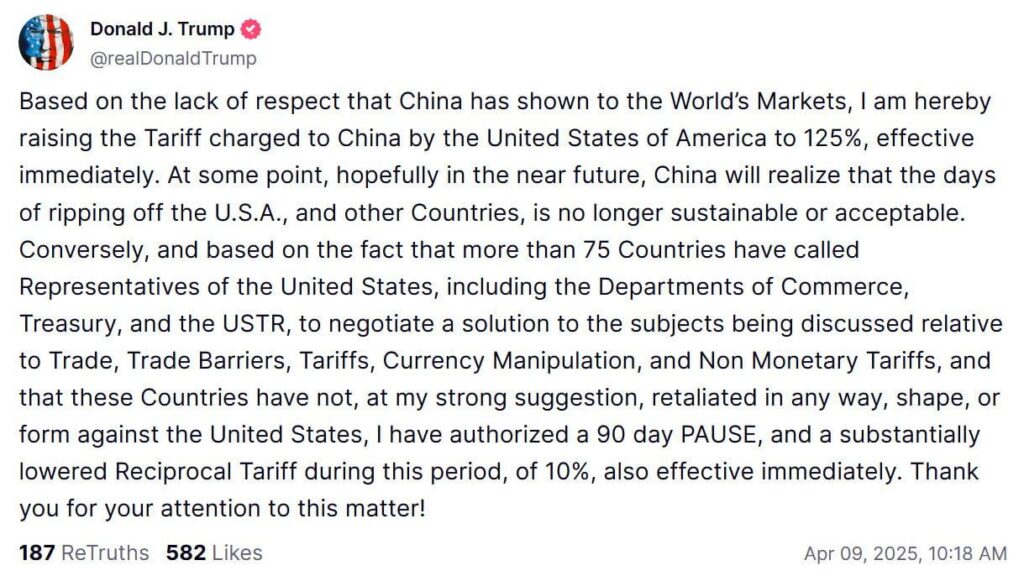On Wednesday, the cryptocurrency market experienced a significant surge following statements from former President Donald Trump regarding tariffs on foreign goods. In a post shared on Truth Social, Trump announced a 90-day reprieve on tariff increases for most countries, implementing a dramatically reduced 10% reciprocal tariff. However, he raised tariffs against China to a striking 125%, effective immediately.
This announcement sent ripples across the financial landscape, boosting Bitcoin (BTC) from around $77,000 to above $81,000—an impressive jump of 5.5% within a 24-hour period. The excitement wasn’t limited to Bitcoin alone; a number of altcoins also saw substantial gains. The CoinDesk 20 Index reflected this rally, showcasing notable increases for cryptocurrencies such as XRP, Solana’s SOL, Avalanche’s AVAX, Chainlink’s LINK, Hedera’s HBAR, and SUI, all of which climbed over 10%. Ethereum’s ETH also benefited from the positive sentiment, rising to $1,600, marking an 8% increase during this time.
Furthermore, the stock market mirrored the optimistic mood, with major indexes like the Nasdaq and the tech-focused S&P 500 climbing 7% and 8.8%, respectively. Earlier that day, Trump had declared it was “a great time to buy,” further fueling market enthusiasm.
The open dialogue about tariffs and trade dynamics continues to play a crucial role in shaping market expectations and investment behavior.
Impact of Trump’s Tariff Announcement on Cryptocurrencies
The recent announcement by Donald Trump regarding tariff adjustments has significant implications for the cryptocurrency market and could potentially influence investors’ perspectives and decisions.
- Tariff Reductions:
- Trump announced a 90-day delay on tariffs against most countries, reducing the rate to 10% (excluding China).
- This reduction may boost investor confidence in international trade, positively influencing market sentiment.
- Increased Tariffs on China:
- Tariffs for China were raised to 125%, effective immediately.
- This could escalate tensions in U.S.-China trade relations, potentially impacting global markets.
- Cryptocurrency Surge:
- Bitcoin (BTC) surged from $77,000 to over $81,000, representing a 5.5% increase in 24 hours.
- Major altcoins like XRP, SOL, and AVAX experienced gains of over 10%, indicating strong market optimism.
- Ethereum (ETH) rose by 8%, showcasing a positive trend across various cryptocurrencies.
- Broader Market Reaction:
- U.S. stock indices reacted positively, with the Nasdaq increasing by 7% and the S&P 500 by 8.8%.
- The positive correlation between crypto and stock markets suggests that market sentiment can drive both asset classes.
- Trump’s Suggestion to Buy:
- Trump implied it was “a great time to buy,” potentially influencing investor behavior in both crypto and stock markets.
- This statement may encourage retail investors to enter the market, further inflating prices.
Tariff adjustments have ripple effects in the financial markets, influencing investor sentiment and market dynamics in cryptocurrencies and traditional stocks.
Analyzing the Impact of Trump’s Tariff Announcement on Cryptocurrency Markets
The recent announcement by Donald Trump regarding the revision of tariff policies has sent shocks through both traditional and digital markets. While the details may be specific to the political landscape, the implications echo widely within the financial world, creating both opportunities and challenges across various sectors.
Competitive Advantages: The strategic delay and reduction of tariffs for most countries, juxtaposed with the sharp increase for China, injects an air of optimism into the cryptocurrency sphere. As Bitcoin surged past $81,000 and many altcoins experienced double-digit gains, this bullish momentum suggests that investors may see cryptocurrencies as a hedge against traditional economic uncertainties. This newfound enthusiasm could attract more retail and institutional investors into the crypto market who might have been hesitant previously. The favorable reaction also expands the narrative surrounding the strengthening position of cryptocurrencies as alternatives to conventional assets, particularly in times of geopolitical strain.
Potential Disadvantages: On the flip side, the drastic hike in tariffs on China raises concerns about escalating trade tensions and the potential ripple effects on the global economy. Investors may respond by pulling back from the volatile nature of cryptocurrencies if they perceive that economic instability is imminent. Furthermore, Trump’s polarizing figure and the unpredictability of his policies could discourage some investors from entering the crypto market. Those already wary of the risks associated with digital currencies might see this news as a reason to stay away, fearing a backlash from the broader financial landscape.
In terms of beneficiaries, cryptocurrency enthusiasts and investors stand to gain significantly from the increased enthusiasm surrounding digital assets. The surge in both Bitcoin and altcoins indicates a renewed confidence that could translate into inflows of capital, enhancing liquidity within the market. Conversely, organizations involved in international trade, especially those tied closely to Chinese markets, may find themselves grappling with increased costs and potential supply chain disruptions, leading to greater volatility in their operations.
This mixed bag of advantages and disadvantages suggests that while opportunities abound in the crypto sector amid shifting economic landscapes, caution is advised. Navigating these turbulent waters will require both investors and businesses to keep a close eye on evolving economic indicators and remain flexible in their strategies.















